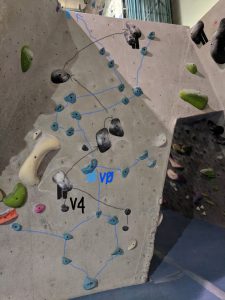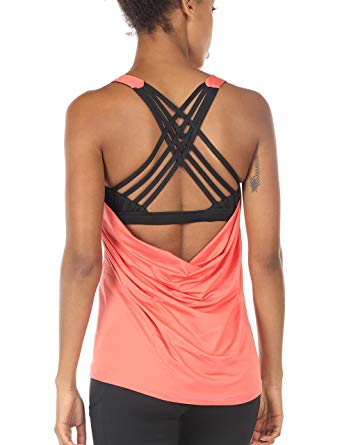When starting out with rock climbing, bouldering was not on my radar. I gravitated more to sport climbing with the rope and harness. It seemed a lot safer when I fall. I didn’t even know boulder existed until my son joined the climbing team. All I know was that bouldering has shorter routes and more stress on the body. It does not require rope or harness because it does not get taller than six meters or twenty feet high. Being above fifteen feet is still pretty high in my book. The major equipment you would need is a pair of climbing shoes, chalk so you can stick to the rocks and mattes for a soft landing.
After several years of sport climbing, I finally build the courage to explore bouldering. A mind is a powerful tool. If I think I can, then I can and vice versa. I started the easiest bouldering route at the gym which was a rating of V0 and slowly build confidence.
I tried several times in the beginning and did not like it too much. The holds are pretty rough on my hands. I was probably being a wimp because it was painful. When bouldering, I am pretty much holding up my own weight with no support from the rope. It is so much less forgiving. I also do not like to drop or jump down from the top of the routes. The kids on the team can jump all day long but it’s totally scary for me. I was gladly and readily to jump back to sport climbing using the rope.
Finally this past September, Aiguille Rock Climbing Center held a youth bouldering competition. They left all the boulder routes up for a week. There were no new top rope routes set up because of the competition. I was getting bored climbing the same top rope routes over and over again. I decided to give bouldering another try. To my surprise, I enjoyed bouldering more this time.
Advantages and Disadvantages of Bouldering
I can definitely see the advantages of bouldering. I do not need to have a partner to climb. Bouldering also help increase upper body strength and improve on feet techniques as well. I noticed that my grip strength improved when I climbed top rope.
The negative aspect is the stress on my joints. The harder the routes the more stress I put on my little old body. The routes are short so in order to challenge the climber the handholds or feet positions can be awkward and require flexibility, strength, and endurance from one move to the next. You can definitely pull a muscle or a tendon easily if you forget to stretch before you start.
Grading Breakdown difficulties in a Climbing Gym
The grading system for bouldering is totally different from sport climbing. The most common grading scale used today in the US is the V-scale. The grade starts with the letter V which is short for “Verm” or “Vermin”. Vermin is a nickname for John Sherman who is an American pioneer boulderer. He originated the V-scale for rating the boulder problems.
The V-scale starts with the easiest being V0 and goes all the way up to V17 which is the hardest so far for outdoor climbing in the world. The gym where I climb has the highest grade of V13. There is no top-level of difficulty. The highest grade will increase as climbers reach new limits.
Each gym has its own system on setting routes. Aiguille color-coded their routes. The starting point is at the first set of double tape at the bottom of the route. The ending point is the single tape or double tape at the top. You would climb the same color hold from the bottom to the top.
V0 — It is almost like climbing up the steps where the handholds are big and Juggy and the feet holds are large  and within reach. There are 23 holds in the blue route. The blue route in the picture is a V0.
and within reach. There are 23 holds in the blue route. The blue route in the picture is a V0.
V1 — The holds are still mostly Juggy and the steps are becoming smaller and less straightforward as the steps for V0.
V2 — The handholds are now smaller with sometimes crimpy, slopy, or pinchy holds. It requires more thoughts of where to position your feet and hands in order to climb to the top of the route. Sometimes there is an incline being introduced to V2 routes.
V3 — This rating definitely requires more power and strength on the grip. The positioning of the body and the feet are crucial to achieve efficiency. The hand and feet holds are smaller with fewer holds as the grades get harder.
 V4 — Most of this rating could be on an incline or a roof like an incline, requires a dynamic move, and much less hand/feet holds. I am currently climbing in between V3 and V4. I can climb some V3s and occasional V4s. In the picture above, there are only nine holds for the black V4 route.
V4 — Most of this rating could be on an incline or a roof like an incline, requires a dynamic move, and much less hand/feet holds. I am currently climbing in between V3 and V4. I can climb some V3s and occasional V4s. In the picture above, there are only nine holds for the black V4 route.
V5 and up — Much more difficult and not yet on my radar. Some requires a dynamic move calls a “dyno” which is an extended leap from one hold to another. The handholds are smaller in general which requires power, strength, and precise movement of the feet.
I bouldered outdoor once and I found it more difficult than bouldering indoor. The real rock texture takes time to get used to. It is a lot rougher than climbing with the gym plastic holds. The smearing of the feet against the rocks also requires getting used to as well. However, when I bouldered outdoor, I gained a lot more confidence to boulder indoor.
I hope this article is helpful for you to understand bouldering grades. I love to hear your thoughts regarding bouldering. Please leave comments below.





